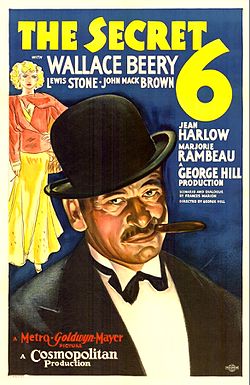Inspiration
Attached to Frances Marion’s script for the movie was an August 16, 1930, Saturday Evening Post article about the Secret Six, a well-funded, Chicago-based group of vigilantes who operated from 1930 to 1933, when mistakes and scandals ended the effort. The article, entitled “Business Fights Crime in Chicago,” was authored by Secret Six founder Col. Robert Isham Randolph. [2]
“This tribunal,” declared a prosecutor early in the film, “known only as the Secret Six, represents the greatest force for law and order in the United States. These men have gathered together to fight and destroy the vicious power of the gangster.” The movie had little to do with the real Secret Six, however, taking place not in Chicago but in Central, and ignoring the considerable work done by the real Secret Six to investigate and solve kidnappings, extortions, theft and murder.
The movie portrayed its crimefighters as six middle-aged business men in suits and wearing masks. Through means left unexplained in the movie, the men obtained warrants for tax evasion and arson against Scorpio and his gang members, and promised to have some of them deported and their lawyer disbarred.
Context
The film was Ralph Bellamy's first screen role in what became a six-decade career. Despite being billed seventh in the cast, Clark Gable has more screen time than this implies, and much greater impact. Beery and Gable made Hell Divers (1932) the following year, this time with Gable's role and billing almost as large as Beery's. Beery, Harlow and Gable would work together again four years later in the epic seafaring adventure China Seas (1935), only with their billing reversed and all three names (Gable, Harlow and Beery) above the title.
Harlow and Gable would work together in five other films, Red Dust (1932), Hold Your Man (1933), China Seas (1935), Wife vs. Secretary (1936) and Saratoga (1937). [3]
Harlow and Lewis Stone would work together in four other films, Red-Headed Woman (1932), The Girl from Missouri (1934), China Seas (1935) and Suzy (1936). [4]
This page is based on this
Wikipedia article Text is available under the
CC BY-SA 4.0 license; additional terms may apply.
Images, videos and audio are available under their respective licenses.

